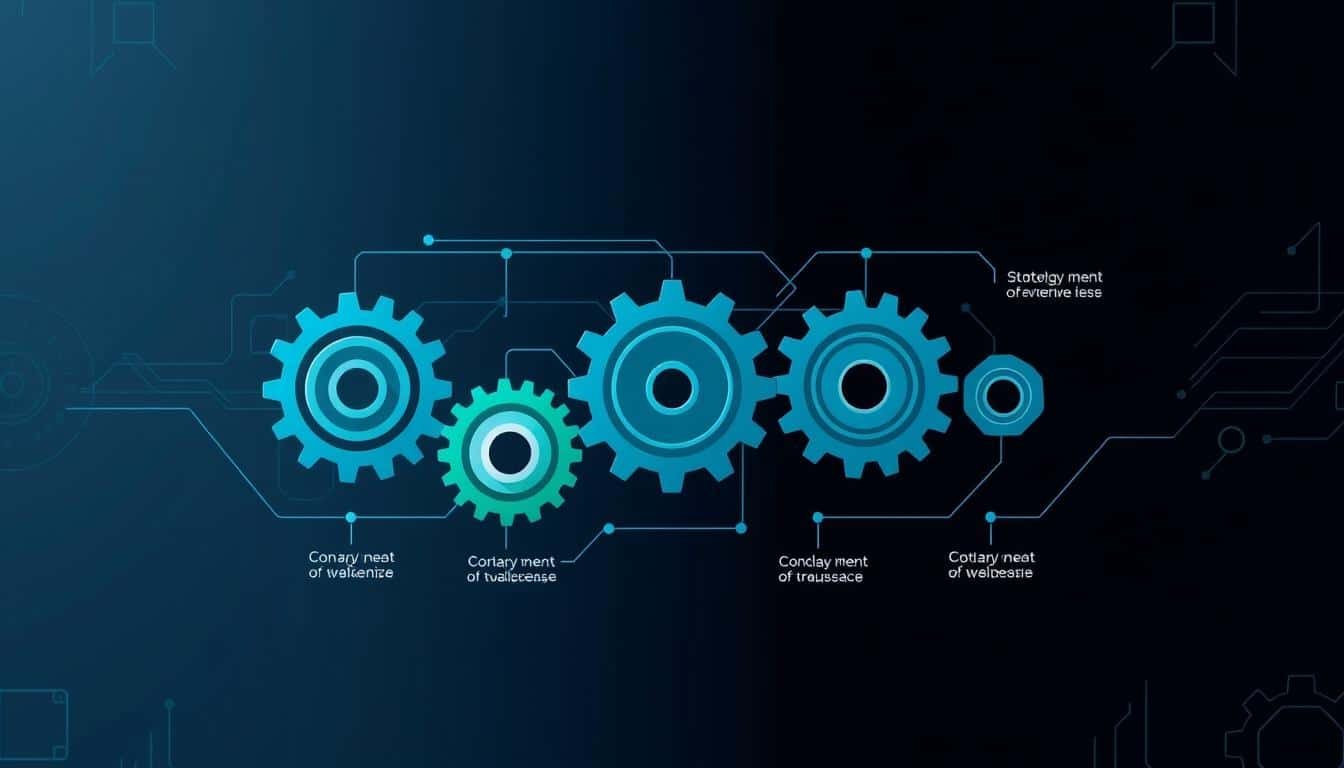The software development lifecycle (SDLC) is a framework that outlines the essential steps for making a software application. It guides developers through stages from planning and design to implementation, testing, deployment, and maintenance. Knowing the key phases of SDLC is key for teams to make software that is high-quality, user-friendly, and meets project goals.
Key Takeaways
- The software development lifecycle (SDLC) is a structured process for building software applications.
- SDLC includes several key phases, such as planning, design, development, testing, deployment, and maintenance.
- Adhering to a well-defined SDLC helps ensure software projects are completed on time, within budget, and meet user requirements.
- The specific SDLC methodology can vary, with approaches like Waterfall, Agile, and DevOps gaining popularity in the industry.
- Mastering the SDLC phases is essential for software developers and teams to deliver successful, high-quality software products.
Understanding the Software Development Life Cycle (SDLC)
The software development life cycle (SDLC) is a step-by-step plan. It helps software developers design, create, and deliver top-quality software. The main aim is to make software that is both affordable and meets what customers need.
Definition and Purpose of SDLC
The SDLC is a detailed plan for making, keeping up, and replacing software. It covers all stages from planning and gathering requirements to deploying and maintaining the software.
Benefits of Adhering to a Structured SDLC
- Improved planning and project management: The SDLC gives a clear plan for setting goals, figuring out timelines, and using resources well.
- Reduced costs and increased efficiency: Following a set process helps the team spot and fix problems early, cutting down the project’s cost.
- Enhanced software quality: The SDLC puts a big focus on testing and quality checks, making sure the software is up to standard.
- Faster and more reliable software deployment: The SDLC’s structured way makes delivering software quicker and more predictable.
Following a structured SDLC is key for developers, software engineers, and development teams. It helps them deliver top-notch software applications.
The 7 Phases of the Software Development Life Cycle

The software development life cycle (SDLC) is a structured way to make and deliver top-quality software. It has seven main phases: planning, gathering and analyzing requirements, design, coding, testing, deployment, and maintenance.
These phases usually happen one after the other, but sometimes, two can happen at the same time. Each step is key to making a software project successful. It makes sure the final product meets what users and stakeholders need.
- Planning: This phase sets the project goals, scope, and timeline. It also finds out who and what resources are needed to finish the work.
- Requirements Gathering and Analysis: Here, the team collects and looks at what the software must have to meet user and stakeholder needs.
- Design: In this phase, a detailed plan for the software is made. This includes the look, structure, and technical details.
- Coding or Implementation: This phase is about making the software real, following coding rules and best practices.
- Testing: Testing is key to check the software’s quality and how it works. Different tests are done to find and fix problems or bugs.
- Deployment: The software is released to users in this phase. The needed systems and support are ready.
- Maintenance: This phase is for ongoing support, fixing bugs, security updates, and adding new features based on user feedback.
Following a structured SDLC helps software development teams deliver projects on time, within budget, and with the right quality and features.
Planning Phase: Defining Project Goals and Requirements
The planning phase is key in the software development life cycle. Here, the team collects info from stakeholders, sets project goals, and outlines what the software application will do. This groundwork helps plan the rest of the software development process.
Gathering Information and Setting Expectations
The planning starts with requirements gathering. The development team works with clients, users, and experts to grasp the project’s goals and needs. They use this info to craft a detailed software requirement specification document. This document is the project’s guide.
Estimating Costs, Timelines, and Resources
Knowing the project’s needs, the development team tackles cost estimation, timeline planning, and resource allocation. They look at the project’s scope, figure out the programming tasks, and estimate time and resources needed. This leads to a detailed project plan, helping software developers know what to do next.
“Successful project management is about finding the right balance between project goals, available resources, and the constraints of time, budget, and quality.”
Design Phase: Architecting the Software Solution

The design phase is key in the software development life cycle. It turns project needs into a workable software architecture. Engineers look at the project’s needs and pick the best solutions to make the software application they want.
Important tasks in the design phase are:
- Integrating pre-existing software modules or components
- Choosing the right programming languages, development tools, and software technologies
- Planning how the new software will work with current IT infrastructure
- Designing the user interface (UI) and user experience (UX)
- Looking at security and performance needs
Stakeholders review the design to get feedback and ideas before moving to the next step. This teamwork makes sure the final software solution hits the project’s targets and fits what the developer and user want.
“Effective software design is not just about technical implementation, but also about understanding user requirements and crafting an intuitive, secure, and high-performing application.”
By planning and designing the software architecture well, software developers set up a strong base for a software project that adds value to users.
Development Phase: Writing and Implementing the Code

The development phase is where the magic happens in software creation. Developers turn design specs into a working software here. They use coding guidelines and best practices to make the code clean, efficient, and easy to maintain.
Coding Guidelines and Best Practices
Following coding guidelines is key for keeping the code quality high. These guidelines include standards for naming, formatting, commenting, and handling errors. By sticking to these best practices, developers make code that’s easy to read and work on together.
Collaboration and Version Control
Building software often means a team works together on the same code. Collaboration and version control are vital during this phase. Tools like Git and GitHub help developers work together, track changes, and solve conflicts. This keeps the project organized and lets the team blend their work smoothly.
| Coding Guidelines | Collaboration Tools |
|---|---|
|
|
“Debugging is twice as hard as writing the code in the first place. Therefore, if you write the code as cleverly as possible, you are, by definition, not smart enough to debug it.” – Brian Kernighan
Testing Phase: Ensuring Quality and Functionality

The software development life cycle is a step-by-step process. The testing phase is key to making sure the software works well and meets quality standards. Developers and quality assurance teams use both automated and manual testing to find and fix bugs.
Types of Testing
There are different types of testing in the software development life cycle. Each type has its own goal:
- Unit Testing – This checks individual parts of the software to make sure they work right.
- Integration Testing – This makes sure different parts of the software work well together.
- Performance Testing – This checks how the software performs under heavy loads and stress.
Bug Tracking and Fixing
When testing finds bugs, they are tracked using special software. The development team then fixes these bugs. They keep testing until the software is stable and ready for release. This process keeps going until the software meets the needed quality and customer expectations.
| Testing Type | Purpose |
|---|---|
| Unit Testing | Verify individual components or modules |
| Integration Testing | Ensure seamless integration between components |
| Performance Testing | Evaluate software under different loads and constraints |
By following a detailed software development life cycle with thorough testing, developers can make sure the software is top-notch before it’s released.
software development Deployment: Releasing the Application

The deployment phase is key in the software development life cycle. It moves the latest software build from development to the production environment. Here, customers can use the software application. The process includes packaging, configuring, and installing the software.
Before the final software release, a small test is done on the production environment. This helps find and fix any issues early. It reduces problems for users.
Developers, software developers, and the operations team work together here. They make sure the software deployment goes smoothly. This keeps the software project on track.
“Successful software deployment is the ultimate goal of the software development life cycle. It’s the moment when all the hard work and planning come together to deliver value to the end-user.”
With a well-planned deployment phase, companies can release their software application smoothly. This gives customers a good experience.
Maintenance Phase: Ongoing Support and Improvement
The software development life cycle doesn’t stop after the first release. The maintenance phase is key, focusing on ongoing support and making the software better over time. It includes fixing bugs, updating security, and using user feedback.
Bug Fixes and Security Updates
Users may find bugs in the software. The team must quickly fix these issues. They also need to check the software for security risks and update it to keep users and their data safe.
Incorporating User Feedback and Enhancements
It’s important to listen to what users say to make the software better. The team should talk to customers, get their feedback, and use it to improve the software. This could mean adding new features or making the user experience smoother.
Putting effort into the maintenance phase helps keep software reliable and secure. It also makes sure it keeps up with what users need. This is key to the long-term success of any software project.
Also Read : What Are The Key Components Of E-Commerce Technology?
Conclusion
The software development life cycle is a detailed process. It helps developers and teams make strong, working software applications. By following the SDLC, projects are well-planned and deliver top-notch results that users need.
From planning to testing and maintenance, developers use their skills in programming and teamwork. This makes sure software projects succeed. Following best practices and a structured SDLC cuts costs, shortens timelines, and improves software quality.
The software development life cycle is key to making innovative, user-focused apps. These apps help businesses succeed and improve digital experiences for users. By using the SDLC, developers can keep improving their skills and meet changing needs. They deliver software that goes beyond what users expect.
FAQs
Q: What are the key phases of the software development lifecycle?
A: The key phases of the software development lifecycle include requirement analysis, planning, design, implementation, testing, deployment, and maintenance. Each phase is crucial for effective software development.
Q: How does the software development process differ among various methodologies?
A: Different software development methodologies, such as Agile, Waterfall, and DevOps, structure the software development process in unique ways. Agile emphasizes iterative development and flexibility, while Waterfall follows a more linear approach.
Q: What types of software can be developed using the software development lifecycle?
A: The software development lifecycle can be used to create various types of software, including application software, system software, web applications, and enterprise software. Each type may require different development tools and methodologies.
Q: What are the steps in the software development process?
A: The steps in the software development process typically include gathering requirements, planning the project, designing the software architecture, coding, testing the software, deploying it, and maintaining the application for future updates.
Q: Why is effective software development important for developers?
A: Effective software development is crucial for developers as it ensures the delivery of high-quality software products that meet user needs, are maintainable, and can evolve with changing requirements. This ultimately enhances user satisfaction and reduces long-term costs.
Q: How do development tools impact the software development lifecycle?
A: Development tools play a significant role in the software development lifecycle by streamlining various processes, enhancing collaboration, and improving code quality. Tools like integrated development environments (IDEs) and version control systems are essential for efficient application development.
Q: What programming languages are commonly used in software development?
A: Several programming languages are commonly used in software development, including Java, Python, C#, and JavaScript. The choice of programming language often depends on the project requirements and the types of software being developed.
Q: How does iterative development fit into the software development lifecycle?
A: Iterative development is a key aspect of the software development lifecycle that allows developers to revisit earlier stages, refine features, and adapt to changes based on feedback. This approach enhances flexibility and can lead to higher quality software products.
Q: What is the role of project management in the software development process?
A: Project management is essential in the software development process as it involves planning, executing, and monitoring development projects. Effective project management ensures that projects stay on track, within budget, and meet deadlines while maintaining communication among team members.




